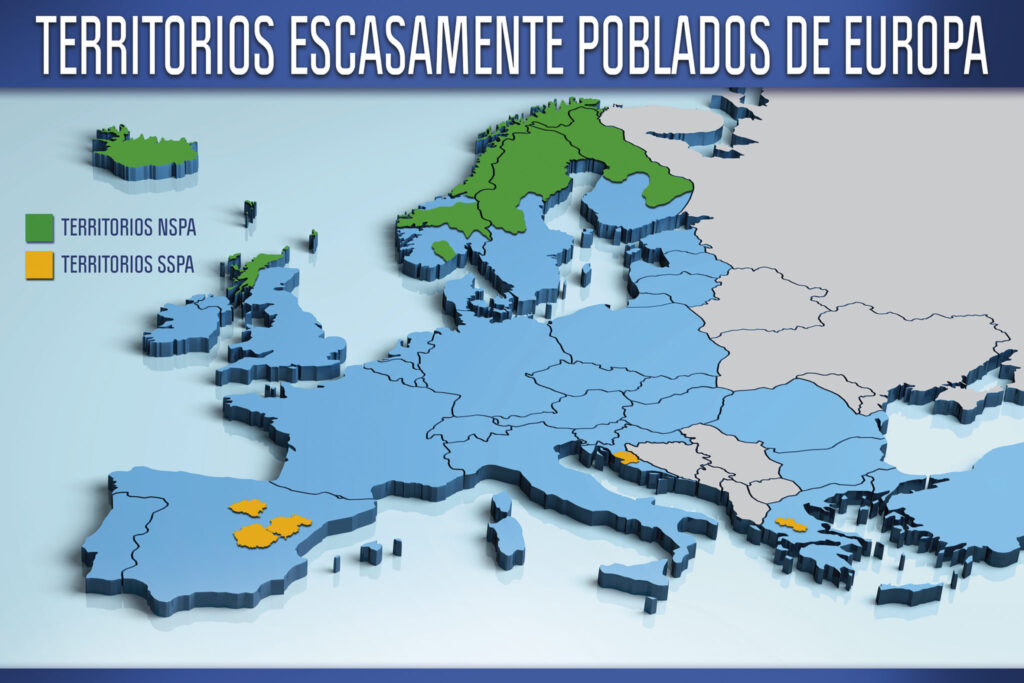
The demographic challenge, a challenge of contrasts. The case of Spain
You have probably heard or read in the news that many villages in the so-called “Empty Spain” are offering housing and work for those seeking new opportunities away from the big cities. Perhaps it may seem a desperate measure by these areas to cope with the the continuous loss of population they have been suffering over the last decades but, in reality, it is another measure to face the territorial challenge in which we are immersed due to the existence of two opposing processes; one of concentration of population and activities in urban areas and the other of decline or stagnation of rural areas.
For all these reasons, there is no longer any doubt that the demographic challenge must and is acquiring unprecedented notoriety in the political, economic and social agenda of our country, as the reflection of the current territorial model requires an integrating vision from the State. Even more so if it is tackled jointly with the ecological transition and the objectives established in the 2030 Agenda, the Paris Agreement on climate change or the New Urban Agenda, all managed by the Ministry for Ecological Transition and the Demographic Challenge.
But what is the demographic challenge?
The demographic challenge is a “complex” and multifactorial idea that encompasses population dynamics, i.e. changes in the structure population (birth rate, average age, masculinity rate, etc.) as well as the settlement pattern (how population is distributed in the territory), including both depopulation and overpopulation.
Although in the case of Spain the focus (at least in the media) has been placed on the rural areas more affected by depopulation, the demographic challenge also covers urban areas, where the problem is the opposite, i.e. a large concentration of population in a small territory. Both processes, depopulation and overpopulation, have effects on the structuring of the territory, the consumption of raw materials,the employment rate or economic development, and accesibility to resources.
But let´s stop to understand why this is a challenge in our country. In Spain,83% of the population is concentrated between Madrid, the coast, and in the valleys of large rivers such as the Ebro and the Guadalquivir, as a result of a historically greater economic development, thus concentrating numerous companies from different sectors (industrial, technological, etc.)
As a consequence, the remaining 17% is concentrated in the rest of the territory, where, to highlight some figures, they are affected by negative vegetative growth (6,300 of Spain´s 8,000 municipalities, i.e. 80% are losing population). Although it is true that this process of population loss is not new, it has worsened over time.

Is easy to identify ,then, that these territories stand out for their very low population density values; almost half of Spain´s municipalities have a population density of less than 12.5 inhabitants/km2, the threshold that the European Union classifies as “demographic risk”, and most of them have less than 8 inhabitants/km2, i.e. they are extremely depopulated. The provinces most affected include Soria, Cuenca and Teruel.
Once the demographic and territorial challenge we face in Spain has been contextualised, it is necessary to go further and identify its causes and consequences in order to tackle it more efficiently. Fortunately or unfortunately, this is a clear example of what is commonly known as “fish that bites its own tail”, i.e. a factor that motivates population displacement between territories produces effects or consequences that eventually become the cause of the same.
One of the main causes and consequences of the migration of the population residing in these areas is attributed to several factors. The first one is the predominant economic sector, as technological progress in predominantly agricultural areas has led to a higher level of automation, with a consequent reduction in the labour force, and therefore in the labour supply. Secondly, and closely relately to the first, is the lack of job diversity, and last but not least, the lack of services (housing, education, leisure, transport, etc.) that meet the needs of a 21st century society.

All of the above is aggravated by the declining birth rate, which, although it is a nationwide problem, is more acute in regions with smaller populations.
A direct consequence of population decline is a reduction in demand for public services, such as education, health care, transport and social security. This, in many cases, leads to cuts in the budget allocated to their management, as they become less economically sustainable. As a result, the supply of essential services may be compromised, particularly affecting the most vulnerable groups in society.
Fortunately, we are not alone, and the demographic challenge is not only a problem in Spain, which is why the European Union, aware of this problem, has carried out a zoning of European regions in order to apply more specific and effective policies and measures in each area, taking into account the level of economic development, population density, availability of natural resources, and geographical location, among other aspects.
Also at European level we find the Southern European Sparsely Populated Areas Network (SSPA Network). This agency focuses on the economic sector and aims to promote, together with the agents of the territory, specific policies and measures that contribute to tackling the main structural challenges affecting the least populated rural regions of Europe. The provinces of Soria, Teruel and Cuenca are part of this network, territories that according to European Union criteria are at high risk of depopulation, so it is important to try to stop and reverse their situation as a matter of urgency.
With regard to the policies developed in Spain in relation to the demographic challenge, there have been numerous and all of them focused on alleviating the effects of depopulation, all of them with the aim of tackling Article 174 of the Treaty on the Functioning of the European Union (TFEU), which seeks to reduce the differences in development between the different regions.
Among the most noteworthy policies, and in which citizen participation has been promoted, are the General Guidelines of the National Strategy against the Demographic Challenge, the package of 130 Measures to face the Demographic Challenge, as well as the Strategy for the development of areas with depopulation and socio-economic decline in Castilla la Mancha or the Special Directive for Demographic Policy and against Depopulation in Aragon.

Broadly speaking, the measures or strategies included in these policies are the creation of employment, the improvement of infrastructures and services, and support for entrepreneurs and small businesses. In addition, better access to housing and essential services, such as education and health.
Despite the fact that depopulation is a serious problem, there are several regions that are making an effort to curb it and even gain population, such as the Scottish Highlands or Artieda (Zaragoza).
Thanks to the creation, more than 60 years ago, of an economic and community development agency, with autonomy of action and depoliticised, they have managed to reverse the trend in the Highlands of Scotland, with the population expected to increase by 10% by 2035 compared to 2010. This is due to providing infrastructure and housing, as well as trying to improve the availability of basic services, commerce, culture, leisure and connectivity.
Another success story, but on a national level, can be found in Artieda, which started with 67 inhabitants in 2017, and thanks to the promotion of housing policies, employment, improved leisure and internet access, has managed to increase its population to 82 inhabitants in 2022, with 15 young people having settled in the municipality. In order for the initiatives and projects being carried out in this region to have had an effect, citizen participation and the ideas contributed by the population have been key.
At CARTIF we are aware of the challenge, not only because of our location in a region suffering from depopulation, but also as an active part in tackling it. In particular in the SPANDAM project, in which we work on the development of integrated evaluation tools and models that allow us to quantify the impact of policies that seek the fixation of population through actions in search of local development and the promotion of its attractiveness.